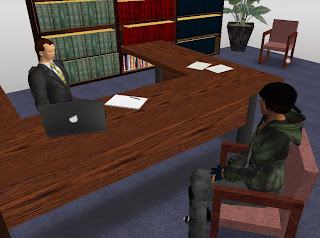

How can we train medical students to take a good history in a safe environment before they start working with real patients?
One method we often use is "standardized patients" who are trained to act like patients with particular medical problems. These encounters can be video taped for later review. This is generally an excellent method for training medical students but has some drawbacks:
- Expense
- Convenience
- Scheduling problems
- Shortage of well-trained standardized patients.
- Informed consent for use of video
We are working on a project to test the feasibility of using SL for training students on history taking and presented a poster on this at a recent education retreat at Case Western Reserve University School of Medicine. At present we are working on creating the appropriate settings and emotions and gestures for a test case (Special thanks to Sue Shick for these images). Should have some results in the next 12 months.
Addendum (3/30/09)
CNN just ran a story on the Imperial College of London efforts in SL
Sounds cool. This does seem to be something that could work. Keep the posts coming!
ReplyDelete